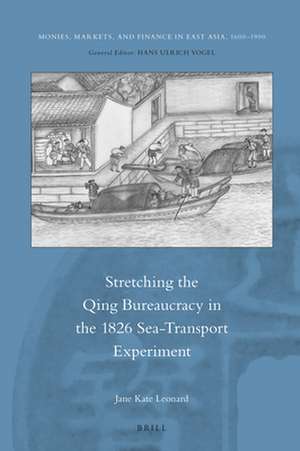Stretching the Qing Bureaucracy in the 1826 Sea-Transport Experiment: Monies, Markets, and Finance in East Asia, 1600-1900, cartea 12
Autor Jane Kate Leonarden Limba Engleză Hardback – 19 dec 2018
Preț: 520.91 lei
Preț vechi: 635.25 lei
-18% Nou
Puncte Express: 781
Preț estimativ în valută:
99.67€ • 104.35$ • 82.48£
99.67€ • 104.35$ • 82.48£
Carte indisponibilă temporar
Doresc să fiu notificat când acest titlu va fi disponibil:
Se trimite...
Preluare comenzi: 021 569.72.76
Specificații
ISBN-13: 9789004384576
ISBN-10: 900438457X
Pagini: 194
Dimensiuni: 155 x 235 x 18 mm
Greutate: 0.43 kg
Editura: Brill
Colecția Brill
Seria Monies, Markets, and Finance in East Asia, 1600-1900
ISBN-10: 900438457X
Pagini: 194
Dimensiuni: 155 x 235 x 18 mm
Greutate: 0.43 kg
Editura: Brill
Colecția Brill
Seria Monies, Markets, and Finance in East Asia, 1600-1900
Cuprins
Acknowledgments
List of Illustrations
Sea Transport Chronology
Introduction: The Challenge of Innovation. The 1826 Sea-Transport Experiment
1 The 1825 Grand Canal Crisis
2 Tricks of the Trade
1 Linqing and Grand Canal Conditions in Northern Jiangsu
1 Junction Conservancy Work, 1737–1765
2 Protecting the Junction, 1770–1784
3 Last Ditch Efforts to Shield the Junction, 1796–1826
4 Qishan and the Pound Lock, 1827
5 Conclusions
2 Imagination at the Center: The Daoguang Emperor and Yinghe
1 The Daoguang Emperor Launches the Sea-Transport Initiative
2 Yinghe (1771–1839): Principal Architect of the Sea-Transport Plan
3 Yinghe’s First Memorial on the Comprehensive Grain-Transport Plan
4 The Significance of Yinghe’s First Memorial
3 The Deepening Crisis and Yinghe’s Second Memorial
1 The Emperor’s Response
2 The Deepening Crisis at the Junction
3 Intensification of Imperial Crisis Management and Yinghe’s Second Memorial
4 The Challenge of Commutation
5 Conclusions
4 Qishan and Disaster Assessment in Jiangsu
1 Qishan’s Mission
2 Investigation in the Sixth Month (5.6.1–5.6.22)
3 Qishan’s Assessment of the “General Situation”
4 Qishan’s Approach to Sea Transport
5 Conclusions
5 Stretching the Bureaucracy for Sea Transport
1 Administrative Obstacles to the Sea-Transport Experiment
2 Obstacles to Recruitment
3 Qishan and the ad hoc Planning Cadre
4 Tao Zhu’s Special Mission to Shanghai
5 Xiong Yutai’s Advice on Recruitment
6 Conclusions
6 Sea-Transport Regulations and Coastal Defense
1 Sea-Transport Regulations
2 Coastal Defense
3 Redrawing the Northeast Coastal Map
4 The Route
5 Conclusions
7 Nayancheng and Regulations for Zhili
1 Governor-General Nayancheng
2 Yinghe and the First Board of Revenue Memorial
3 Nayancheng and Zhili Grain-Management Realities
4 Lighterage
5 Storage Logistics
6 The Performance of Low-Level Grain-Handing Tasks in Zhili
7 Calculating the Costs Down to the Last 1/100,000th of a Tael
8 Conclusions
8 Bai Chun and Low-Level Grain Transfers and Storage in Zhili
1 The Role of Sub- and Extra-Bureaucratic Granary Personnel
2 Grain Brokerage
3 Brokers and the Inspection of Steamy Rice (zhengzhao)
4 The Broker’s Role in Grain Transfers
5 The Broker’s Role in Escorting Lighterage Fleets
6 Cart Haulage from Tongzhou to the Beijing Granaries
7 Essential Equipment for Grain Transfers
8 Terms, Conditions, and Pay for Lighterage Boatmen
9 Loose Ends
10 Conclusions
Conclusions
Glossary
References
Index
List of Illustrations
Sea Transport Chronology
Introduction: The Challenge of Innovation. The 1826 Sea-Transport Experiment
1 The 1825 Grand Canal Crisis
2 Tricks of the Trade
1 Linqing and Grand Canal Conditions in Northern Jiangsu
1 Junction Conservancy Work, 1737–1765
2 Protecting the Junction, 1770–1784
3 Last Ditch Efforts to Shield the Junction, 1796–1826
4 Qishan and the Pound Lock, 1827
5 Conclusions
2 Imagination at the Center: The Daoguang Emperor and Yinghe
1 The Daoguang Emperor Launches the Sea-Transport Initiative
2 Yinghe (1771–1839): Principal Architect of the Sea-Transport Plan
3 Yinghe’s First Memorial on the Comprehensive Grain-Transport Plan
4 The Significance of Yinghe’s First Memorial
3 The Deepening Crisis and Yinghe’s Second Memorial
1 The Emperor’s Response
2 The Deepening Crisis at the Junction
3 Intensification of Imperial Crisis Management and Yinghe’s Second Memorial
4 The Challenge of Commutation
5 Conclusions
4 Qishan and Disaster Assessment in Jiangsu
1 Qishan’s Mission
2 Investigation in the Sixth Month (5.6.1–5.6.22)
3 Qishan’s Assessment of the “General Situation”
4 Qishan’s Approach to Sea Transport
5 Conclusions
5 Stretching the Bureaucracy for Sea Transport
1 Administrative Obstacles to the Sea-Transport Experiment
2 Obstacles to Recruitment
3 Qishan and the ad hoc Planning Cadre
4 Tao Zhu’s Special Mission to Shanghai
5 Xiong Yutai’s Advice on Recruitment
6 Conclusions
6 Sea-Transport Regulations and Coastal Defense
1 Sea-Transport Regulations
2 Coastal Defense
3 Redrawing the Northeast Coastal Map
4 The Route
5 Conclusions
7 Nayancheng and Regulations for Zhili
1 Governor-General Nayancheng
2 Yinghe and the First Board of Revenue Memorial
3 Nayancheng and Zhili Grain-Management Realities
4 Lighterage
5 Storage Logistics
6 The Performance of Low-Level Grain-Handing Tasks in Zhili
7 Calculating the Costs Down to the Last 1/100,000th of a Tael
8 Conclusions
8 Bai Chun and Low-Level Grain Transfers and Storage in Zhili
1 The Role of Sub- and Extra-Bureaucratic Granary Personnel
2 Grain Brokerage
3 Brokers and the Inspection of Steamy Rice (zhengzhao)
4 The Broker’s Role in Grain Transfers
5 The Broker’s Role in Escorting Lighterage Fleets
6 Cart Haulage from Tongzhou to the Beijing Granaries
7 Essential Equipment for Grain Transfers
8 Terms, Conditions, and Pay for Lighterage Boatmen
9 Loose Ends
10 Conclusions
Conclusions
Glossary
References
Index
Notă biografică
Jane Kate Leonard (Ph.D. Cornell University, 1971) is professor emerita of history (University of Akron). She has published monographs on early nineteenth-century Chinese thought and institutions, including Wei Yuan and China’s Rediscovery of the Maritime World (Harvard East Asian Studies, 1984); “Controlling from Afar.” The Daoguang Emperor’s Management of the Grand Canal Crisis, 1824–1826 (Ann Arbor; Center for Chinese Studies, University of Michigan, 1996).









